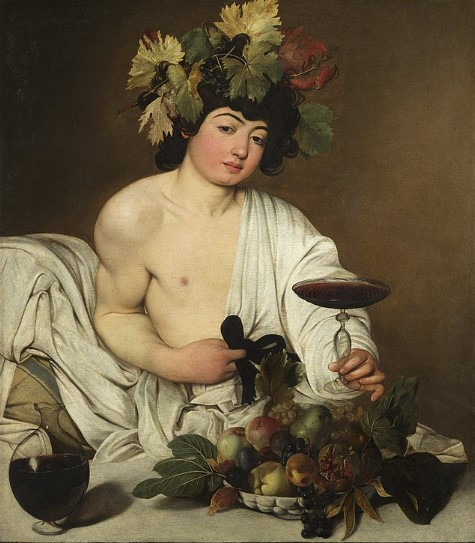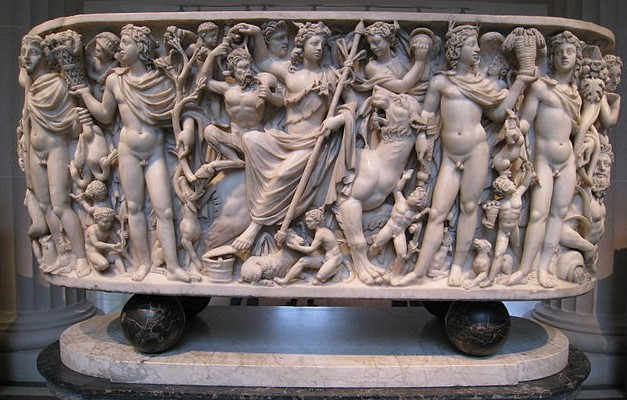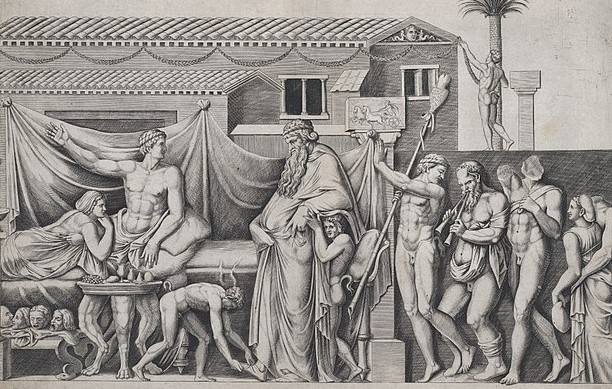Last Updated on November 27, 2023 by Vladimir Vulic
Dionysus, the exhilarating Greek god of wine and revelry, has captivated the imaginations of people throughout history. But there’s more to this fascinating deity than meets the eye! Are you ready to embark on an unforgettable journey into the thrilling world of Dionysus, exploring his mysterious origins, many facets, and enduring influence on culture, art, and religion?
Key Takeaways
- Celebrate the captivating Dionysus, Greek god of wine and revelry!
- Explore his mysterious origins & divine power in ancient art & mythology.
- Revel in modern interpretations of this powerful deity as a symbol of liberation and ecstasy!
The Enigmatic Origins of Dionysus

Dionysus, with his complex origin story and early evidence of worship in ancient Greece, stands out as a uniquely captivating figure in classical Greek religion. His birth and upbringing involve powerful gods, mortal princesses, and divine intervention, while the Greek Dionysus worshipped can be traced back to the 13th century BC on ancient Mycenaean tablets.
It’s intriguing to consider how this enigmatic Greek god of wine and revelry evolved into such a deeply Greek divinity, as the ancient Greeks believed in his significance.
Birth and Upbringing
Born to the mighty Zeus and the beautiful mortal princess Semele, Dionysus’ birth was nothing short of miraculous. Hera, Zeus’ jealous wife, plotted to destroy Semele and her unborn child, but with a Zeus swear, he managed to save the infant Dionysus and entrust his care to Hermes and the nurturing nymphs.
The young god, often referred to as youthful Dionysus, matured to represent the exhilarating aspects of wine, intoxication, and merriment among the Olympian gods. Dionysus’ upbringing was far from ordinary, with his divine heritage and mortal upbringing shaping the god he would become. His connection to the natural world, the arts, and the intoxicating powers of wine would be further explored and celebrated in his worship and the myths surrounding his life.
Early Evidence of Worship
The worship of Dionysus has ancient roots, dating back to the 13th century BC, with Linear B script providing exciting evidence of his veneration in the form of references to festivals and offerings to the god. These early records demonstrate that Dionysus was not a foreign god adopted by the Greeks, but rather a profoundly Greek divinity with a long and storied history.
Apart from the Linear B script, Dionysus’ significance in ancient Greek religion is underlined by joint cults with Zeus on Crete, celebrated as early as the 13th century BC. These early instances of worship showcase the deep connection between Dionysus and the people of Greece, setting the stage for his enduring influence in the centuries to come.
The Many Facets of Dionysus

Dionysus was not just the god of wine and intoxication; he was also the patron of theater, arts, and inspiration, blurring the boundaries between the natural, social, and cultural aspects of his world.
From being the god of wine and intoxication to impacting the arts and theater, Dionysus’ varied aspects positioned him as a central figure in the pantheon of Greek gods. His divine powers and captivating stories continue to intrigue and inspire people to this day.
God of Wine and Intoxication

As the god of wine and intoxication, Dionysus was often depicted with:
- Grapevines
- Thyrsus
- Wine cups
- Wild animals, such as panthers and tigers
His association with these symbols and his power to intoxicate and liberate his followers made him a compelling figure in the ancient world.
Dionysus was also known to punish those who rejected his teachings, demonstrating his wrath and the consequences of defying the gods. His ability to inspire both pleasure and fear in his followers made him an enigmatic and captivating figure within Greek mythology.
The god’s influence extended beyond the realm of wine, as he played a significant role in shaping the cultural landscape of ancient Greece. Dionysus’ influence can be seen in various aspects of Greek culture, including:
- His intoxicating powers, which were believed to inspire creativity and ecstasy
- His association with the natural world, as he was often depicted with vines and grapes
- His connection to the arts and theater, as he was the patron god of drama and festivals
These aspects made Dionysus an indispensable figure in the lives and imaginations of the ancient Greeks, as Dionysus embodied their beliefs and values.
Patron of Theater and Arts
Dionysus’ role as the patron of theater and arts is an essential aspect of his divine persona. The annual festival of Dionysus in Athens celebrated tragedies and comedies, representing some of the most important literary creations of the ancient world. These performances were held in honor of Dionysus, emphasizing the deep connection between the god and the creative arts.
The significance of Dionysus in the arts extended beyond the realm of theater, as he was also worshipped as a god of culture and the arts more broadly. His influence can be seen in various artistic and literary depictions, showcasing the enduring power of this multifaceted deity.
Being the patron of theater and arts, Dionysus significantly shaped the cultural landscape of ancient Greece and his legacy continues to inspire and captivate audiences today. His influence on the arts and theater is a testament to the enduring power and allure of this enigmatic god.
Symbols and Iconography
Dionysus’ symbols and iconography are rich and varied, reflecting the many facets of this captivating deity. Depictions in ancient art often feature Dionysus accompanied by satyrs, silens, maenads, and nymphs, as well as associations with animals such as panthers, tigers, bulls, and serpents. These symbols and images provide a glimpse into the divine world of Dionysus and the powerful forces he represented.
Exploring Dionysus’ symbols and iconography provides a deeper insight into the god’s role in Greek religion and his long-lasting influence on art, culture, and society across history. These compelling images and associations continue to captivate and inspire, revealing the timeless allure of this enigmatic god.
Depictions in Ancient Art
Dionysus was frequently depicted in ancient art, with portrayals often featuring wine, amphora, and wild cats such as leopards, lions, and panthers. These images highlight the god’s close association with wine, intoxication, and the natural world, reflecting his status as the god of wine and revelry.
The god was typically depicted wearing animal skin and carrying a drinking cup or thyrsus. These attributes underscored his connection to the natural world and his role as a divine force of intoxication and liberation.
Ranging from his depiction in ancient art to the symbols and associations defining his divine persona, Dionysus’ iconography delivers a fascinating insight into the world of Greek religion and the beguiling figure of this enigmatic god.
Animal Associations
Dionysus was associated with various animals, including:
- Panthers
- Tigers
- Bulls
- Serpents
These animals were often featured in his iconography and served as symbols of his power, strength, fertility, and abundance, underscoring his role as the god of wine and revelry.
The presence of these animals in ancient art and their connection to Dionysus showcase the multifaceted nature of this fascinating deity. As a god associated with the natural world, Dionysus maintained a unique relationship with the animals that surrounded him, reflecting his status as a powerful force of nature.
The animal associations of Dionysus include:
- The leopard, which represents his wild and untamed nature
- The snake, which symbolizes rebirth and transformation
- The bull, which represents fertility and abundance
- The goat, which is associated with sexuality and indulgence
These powerful symbols and associations continue to intrigue and inspire, revealing the timeless allure of this enigmatic god.
Dionysus in Mythology
Dionysus’ mythology is filled with exciting tales of his travels and conquests across Greece, Turkey, and Asia, as well as his relationships with other gods and mortals. From his marriage to Ariadne, the daughter of King Minos of Crete, to his involvement in various myths and battles, the stories of Dionysus reveal the many facets of this captivating deity and his impact on the ancient world.
Delving into the mythology of Dionysus unveils a world filled with adventure, passion, and divine power. These incredible tales serve not only to entertain, but also to illuminate the enduring influence of Dionysus in the realms of art, culture, and religion.
Travels and Conquests
Dionysus’ travels and conquests took him far and wide, spreading knowledge of the vine and his worship to distant lands. From his exciting adventures in Thrace, where he punished King Lycurgus for his defiance, to his founding of cities in India after defeating the Indian king Deriades, Dionysus demonstrated his divine power and influence throughout the ancient world.
These exhilarating narratives of Dionysus’ travels and conquests highlight the god’s resolve to disseminate his teachings and influence globally. As the god of wine and revelry, Dionysus’ impact can be felt not only in the realms of religion and mythology, but also in the cultural practices and traditions he inspired in the many lands he visited.
Relationships and Family
Dionysus’ relationships and family life were equally fascinating, with his marriage to Ariadne, the daughter of King Minos of Crete, and their children playing a central role in his mythology. This union highlights the god’s connection to other powerful figures in Greek mythology, as well as his role as a divine force in the lives of mortals.
In addition to his marriage to Ariadne, Dionysus was involved in various myths and battles that showcased his divine power and influence. From his retaliation against King Pentheus of Thebes, who refused to acknowledge his divinity, to his invasion of Argos during the reign of Perseus, Dionysus demonstrated his status as a powerful and vengeful god.
Dionysus’ relationships and family life provide a glimpse into the complex world of Greek mythology and the god’s role within it. These engaging stories reveal the many facets of Dionysus and his enduring influence on the lives and imaginations of those who worshipped him.
The Worship and Influence of Dionysus
The worship and influence of Dionysus extended far beyond the confines of Greece, with annual and occasional festivals and rituals dedicated to the god, as well as foreign cults and syncretism with other gods. This widespread veneration of Dionysus highlights the enduring appeal of this enigmatic deity and his impact on the ancient world.
Exploring the worship and influence of Dionysus uncovers a fascinating world filled with religious devotion, cultural exchange, and divine inspiration. These diverse aspects of Dionysus’ worship serve to illuminate the god’s significance in the ancient world and his enduring appeal in the realms of religion, art, and culture.
Festivals and Rituals
Dionysus was honored with a variety of festivals and rituals throughout the ancient world, characterized by:
- Revelry
- Orgies
- Phallic processions
- Animal sacrifices
One such example was the Bacchanalia, a wild and exciting ritual celebrated at night in forests and mountains in Rome, where Dionysus was called Bacchus. However, the Bacchanalia became so out of control that it was banned by the Roman government in the early second century BCE.
These festivals and rituals showcase the exhilarating nature of Dionysus worship and the lengths to which his followers were willing to go in their devotion to the god. The ecstatic celebrations and intoxicating atmosphere of these events captured the essence of Dionysus and his divine power, providing a thrilling glimpse into the world of ancient Greek religion and how they would worship Dionysus.
The orgia, phallic processions, and animal sacrifices associated with Dionysus’ worship further highlight the god’s connection to the natural world and his role as a divine force of intoxication and liberation. These exciting rituals and festivals demonstrate the enduring appeal of Dionysus and the profound impact his worship had on the lives of his followers.
Foreign Cults and Syncretism
Dionysus was identified with foreign gods, such as the Roman Bacchus and Egyptian Osiris, demonstrating a fascinating cultural exchange and religious syncretism between different traditions and religions. This identification showcases the widespread appeal of Dionysus and his influence on the ancient world, as well as the adaptability of his worship and mythology across various cultures.
This syncretism between Dionysus and other gods, such as the Egyptian god Osiris, highlights the interconnected nature of ancient religions and the profound impact that Dionysus had on the lives and beliefs of people throughout the Mediterranean. The enduring appeal of this enigmatic god and his widespread veneration reflect the timeless allure of Dionysus and his role as a divine force in the ancient world.
Dionysus in Popular Culture and Modern Interpretations
Dionysus frequently appears in popular culture and modern interpretations, often portrayed as a wine-loving pleasure seeker. His symbolism and influence can be found in various literary and artistic depictions, reflecting the enduring fascination with this captivating deity and his role in the ancient world.
Ranging from his depiction in literature and art to his representation in contemporary pagan and polytheist groups, Dionysus’ influence persists in modern times. His enduring appeal and the timeless allure of his stories and mythology serve as a testament to the captivating power of this enigmatic god.
Literary and Artistic Depictions
Dionysus has been depicted in literature, art, and theater throughout history, with his influence seen in works such as Euripides’. The Bacchae and modern adaptations of his myths. These depictions showcase the god’s enduring appeal and the profound impact he has had on the worlds of art and literature.
From ancient Greek theater to contemporary literary works, the captivating stories and mythology of Dionysus continue to inspire and influence artists and writers. His presence in these works serves as a testament to the power of his divine persona and the timeless allure of his enigmatic character.
Modern Interpretations and Symbolism
Modern interpretations of Dionysus often focus on his role as a symbol of liberation, ecstasy, and the blurring of boundaries, with some scholars drawing parallels between Dionysus and figures such as Christ. These contemporary perspectives on Dionysus reveal a deeper understanding of the god’s mythology and the profound influence he has had on the human imagination.
Symbolizing liberation and ecstasy, Dionysus persistently captivates and inspires, underscoring the timeless appeal of this enigmatic deity. His influence on the worlds of art, literature, and religion showcases the enduring fascination with Dionysus and the profound impact he has had on the human experience.
Summary
Throughout this exploration of Dionysus, the Greek god of wine and revelry, we’ve delved into his enigmatic origins, many facets, and enduring influence on culture, art, and religion. From his captivating mythology and the exhilarating rituals of his worship to his continued presence in popular culture and modern interpretations, Dionysus remains a fascinating and timeless figure, forever inspiring and captivating the hearts and minds of those who encounter his divine persona.
Frequently Asked Questions
What was Dionysus known for?
Dionysus was the ancient Greek god of wine, winemaking, grape cultivation, fertility, theater, ritual madness, and religious ecstasy. His Roman name was Bacchus.
He is associated with fruitfulness and vegetation, and is known for his joyous disposition and affinity for wine and pleasure.
Who was Dionysus’s boyfriend?
Ampelos was the handsome lover of Dionysus, a Satyr from the Phrygian hills. He and Dionysus were great friends who often swam and hunted together.
He is known as Ampelos de Ampelos in Greek mythology and Bacchus in Roman mythology and either turned into a constellation or the grapevine due to Dionysus.
What is Dionysus’s gender?
Dionysus is a bigender deity, embracing both the male and female gender identities.
They were originally assigned as male, but lived as a girl until reaching adulthood.
Why was Dionysus killed?
Jealousy drove Hera to arrange Dionysus’ demise – the Titans were convinced to tear him apart and eat his body, only sparing his heart which was rescued and later given to Zeus by Athena.
His fate resulted in a powerful myth of death and rebirth for the Greeks.
What is Dionysus the god of?
Dionysus is the Greek god of fertility, wine, pleasure, festivity, madness and wild frenzy. He was known by the Romans as Bacchus and was associated with attributes such as the thyrsos, a drinking cup and an ivy crown.
Excitingly, Dionysus was the son of the supreme god Zeus!
